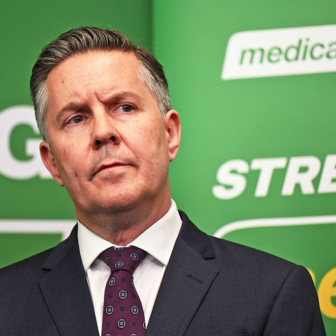IMAGINE TURNING UP for dinner at a restaurant and finding that it doesn’t serve drinks. At this hypothetical restaurant, customers order their food and receive recommendations from their waiter on the appropriate beverages to accompany their meals. They are then asked to go elsewhere to purchase their drinks before bringing them back to the restaurant where they can enjoy them with their meal.
Regardless of how well this restaurant prepares and serves food, at the end of the night you would understandably feel that something was missing from your dining experience. What you wanted from the restaurant was more than just high quality food. You wanted all the elements of an enjoyable meal, including drinks, provided in a single, coordinated package.
When you put this view to the restaurant manager he explains that the speciality of his restaurant lies in the expert preparation and serving of food. He argues that beverages occupy a different area of expertise altogether, requiring him to work with a number of different suppliers and to train his staff in the additional skills they need to work with these products.
Providing both food and drinks also requires the restaurant to assume an additional coordination role to ensure that the right drinks are provided at the right time to the right customers – a complex role which the restaurant manager does not believe he should have to undertake. While the manager understands that it might be more convenient for customers to have their food and drinks served at the one location and in an organised manner, the restaurant already is working to its full capacity and is unable to take on this additional task.
Two weeks later, while still contemplating how your restaurant experience could have been improved, you receive a bill in the mail from the people who washed your dishes after you left the restaurant. When you ring the restaurant to complain, the manager explains that the restaurant prices only cover the preparation and serving of food. Washing-up is a separate service. He also explains that he has no control over the amount charged by the people doing the washing-up. They are private providers who do not work directly for the restaurant. For this reason it was not possible to give you a quote in advance for the cost of the washing-up or provide you with any information about this service and its associated billing arrangements.
A restaurant like this is, thankfully, an absurdity in our customer-focused and competitive food retail industry. But it is a worryingly accurate analogy for the way consumers experience the delivery of health care in Australia.
This is particularly the case for health care provided in the community setting. Commonly known as primary care, it includes the health care that consumers access directly from GPs, physiotherapists and psychologists, as well as some referred services, such as x-rays and pathology. Typically, consumers who require multiple services for the one health condition experience this care as isolated, uncoordinated and fragmented. Even the most straightforward problem requiring a GP consultation and a prescription for medication involves consumers seeing two service providers in two separate locations, paying two separate bills, and coming into contact with at least two government insurance programs and safety-net arrangements.
The problem is compounded for people who have more complex conditions and require care from multiple providers. These consumers often find themselves spending more time travelling between different providers, giving duplicate information to multiple services and filling in paperwork than they spend receiving health care. Furthermore, the health care providers they see often do not communicate with each other, which results in a service that is fragmented and uncoordinated, gives consumers mixed and incomplete information about their condition and does not deliver optimum health outcomes.
Each payment arrangement for care providers is different and often multiple transactions are required, even for single episodes of care. Some involve insurance rebates and subsidies and some are subject to safety-net arrangements, but this can be difficult to determine up front. This makes budgeting difficult. The full amount consumers have to pay for their health care is often not obvious, even for a self-limiting condition. Sometimes consumers receive bills for services they didn’t know they had received, such as additional pathology tests performed on a single blood sample.
The multiple problems associated with this system have become even more pronounced as the rate of chronic conditions in our community increases. Chronic conditions are those that persist over time, such as arthritis, rather than a short-term or “acute” condition such as the flu. Chronic conditions typically require treatment from a number of different health providers or from at least one provider on a number of different occasions.
Due to improvements in the prevention and treatment of acute illnesses, chronic conditions are now the major focus of our health system. In fact, eight out of the top ten conditions that make up our overall burden of disease in Australia are chronic. Improving the prevention and management of these diseases will go a long way towards increasing the overall health and well-being of the community.
Because most chronic conditions are treated in the primary care setting, improving the way in which primary care works is essential if we are to provide better health care. The rate of unnecessary hospital admissions – estimated by the Australian Institute of Health and Welfare to be over 500,000 per year – will also fall as primary care improves.
The potential savings were undoubtedly part of the reason why Labor committed itself to developing a comprehensive primary care policy before last year’s federal election. The policy aimed to improve the delivery of primary care, with a particular focus on improving chronic disease prevention and management. A key part of this policy was the introduction of a number of “GP SuperClinics” to provide a different model of primary care which meets consumers’ needs for comprehensive and coordinated services, as well as dealing with shortages of primary care providers in specific areas.
The SuperClinics co-locate different care providers at the one location and support them with a single administrative structure to help them to share relevant information and streamline billing practices. These services may differ from location to location, depending on local needs, but are likely to include general practitioners (including privately billing GPs), allied health providers (such as physiotherapists, dieticians, podiatrists and occupational therapists), psychology or counselling services (including mental health support programs and drug and alcohol counselling). Consulting rooms would be available for visiting medical specialists. Practice nurses and facilities would be on hand to provide services such as chronic disease management, risk modification counselling, self-management support, care planning and coordination.
The SuperClinics would also provide after hours care, community health education (including state/territory funded community health services), dental services and, in some cases, diagnostic imaging and pathology services. The clinics will also link with other local health services – hospitals, community health centres, allied health and telephone help lines – to provide consumers with a single entry point to the rest of the health system.
Labor allocated $223.2 million over four years as part of its election commitment to establish a number of SuperClinics in key areas of need, with additional support provided by state and territory governments.
GIVEN THE IMPORTANCE of improving primary care services to the overall health and well-being of our community and the general agreement among consumers and other stakeholders that our current system is not providing an optimum service, why – twelve months after the election – has the government not yet opened one SuperClinic?
The short answer is that SuperClinics are a fundamentally different way of providing primary care, and changing anything in the health system takes time, even when the majority of people involved support these changes. Let’s not forget that it took ten years and millions of tax payer dollars to persuade GPs that they would find a computer useful in their work, long after the rest of the community had embraced information technology.
The longer answer is that while some progress has been made in the planning stages, there are some specific roadblocks that are preventing the implementation of the SuperClinics, largely because some health care providers and provider organisations are resisting change.
There has certainly been progress. Agreement has been reached on thirty-one locations for the SuperClinics, including sites in many regional areas with significant workforce shortages where the community has struggled to access low cost, accessible health care. Twenty-one community consultations have been conducted (with more planned) in these locations to gauge community views about how their local SuperClinic should operate and what mix of services it should provide. The consultations have been strongly supported by the communities involved.
But while many health care providers welcome this investment in improving primary care services, some providers (and peak provider groups) fear that SuperClinics will adversely affect existing health and medical services by increasing competition and attracting patients from current practices. The Victorian branch of the Australian Medical Association, for example, says that local doctors do not want “to have to compete with the GP Super Clinics for patients.”
Unfortunately, the benefits to consumers of increased competition and choice within primary health care do not appear to be on the AMA’s radar. Given the clear evidence that the current system is not meeting the needs of many consumers and is not achieving optimum health outcomes, it is unfortunate that the AMA has not embraced this program as an opportunity to improve GP services across the board – especially given that the SuperClinics will be located in areas of workforce shortages where doctors are complaining that they cannot meet demand.
Another source of opposition arises from resistance among some elements of the medical profession to a team-based approach to primary care, in which nurses and other health care workers take on some tasks traditionally provided by doctors. This approach is solidly based on evidence and is in line with both consumer views and changing workforce patterns. Most consumers don’t want or need doctors to provide the low-risk services (such as blood pressure monitoring, medication reviews and wound dressing) that nurses and other health practitioners have been trained to provide.
Australia’s health workforce needs to evolve to meet our changing needs and to reflect developments in medical practice. This has occurred throughout the history of medical practice. If you’ve never been offered a cut and blow-dry by your doctor, it’s because of an agreement made in 1745 in London between barbers and surgeons to formally separate their areas of activity. These two areas of practice had been interchangeable and the professions were not considered separate. Since then, the medical profession has been curiously resistant to further attempts to change the scope of their practice and to hand over responsibility for some tasks to other health care providers. Australian medical groups have been particularly intransigent in this area – we are one of the only countries in the world where routine immunisations are still commonly provided by medical practitioners with over ten years of training.
Given the ageing of the population (and the ageing of the medical workforce) and the consequent increase in demand for health care, we can no longer resist changes to the ways in which our health workforce operates. GP SuperClinics provide one opportunity to put into practice an evidence-based approach to primary care which involves a health care team rather than a single GP.
To successfully implement SuperClinics the government will need to acknowledge and respond to the concerns of medical stakeholders about the effects of competition and workforce changes, without becoming captive to them. It is important to remember that two of our most popular and well-regarded health programs – Medicare and the Pharmaceutical Benefits Scheme – were implemented in the face of vigorous opposition from the medical profession. In fact, looking at the history of health policy in Australia, it is almost a pre-requisite for a successful outcome that a policy initially be opposed by peak medical groups.
This should give health minister Nicola Roxon and her team reassurance that they got it right when they developed the pre-election proposal on SuperClinics. Despite isolated opposition from some medical organisations, they should be encouraged by the high level of community engagement in the consultation process and the enthusiasm of many individual health care providers for this program.
Consumers also have a role to play in supporting the successful roll-out of the SuperClinics. As both the funders and recipients of health care, we are in a more powerful position than we often realise when it comes to shaping the future of our health system. Just as we wouldn’t go back to a restaurant that didn’t provide us with drinks along with our food, we shouldn’t accept a health system which meets only part of our overall health care needs.
GP SuperClinics are one step forward in orienting the delivery of health care around the needs of consumers, rather than health care providers, managers or funding bodies. Despite the opposition, they remain our best opportunity for making real and lasting changes to our primary health care system for the future benefit of all Australians. •




